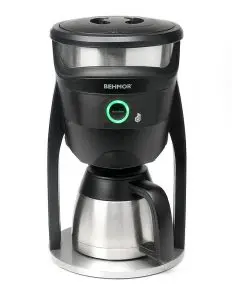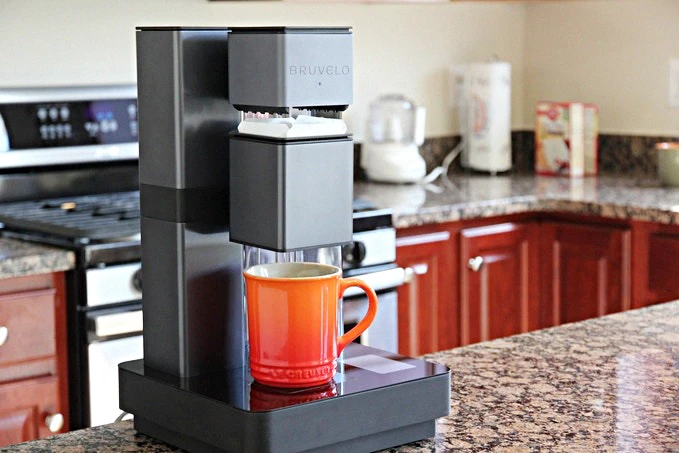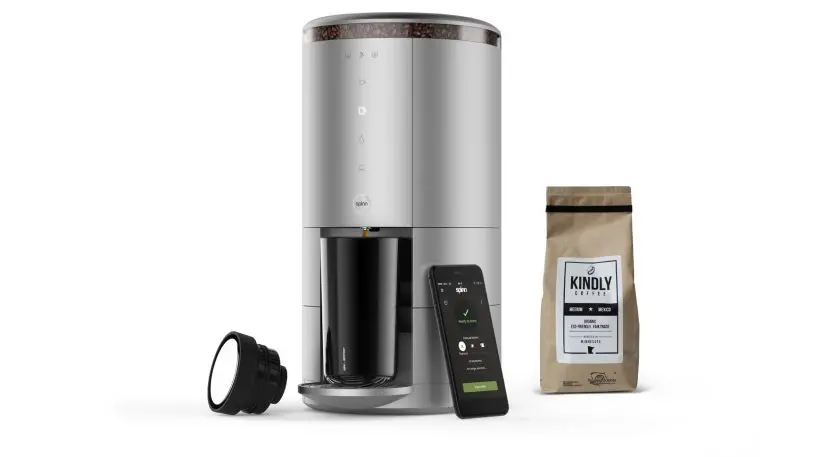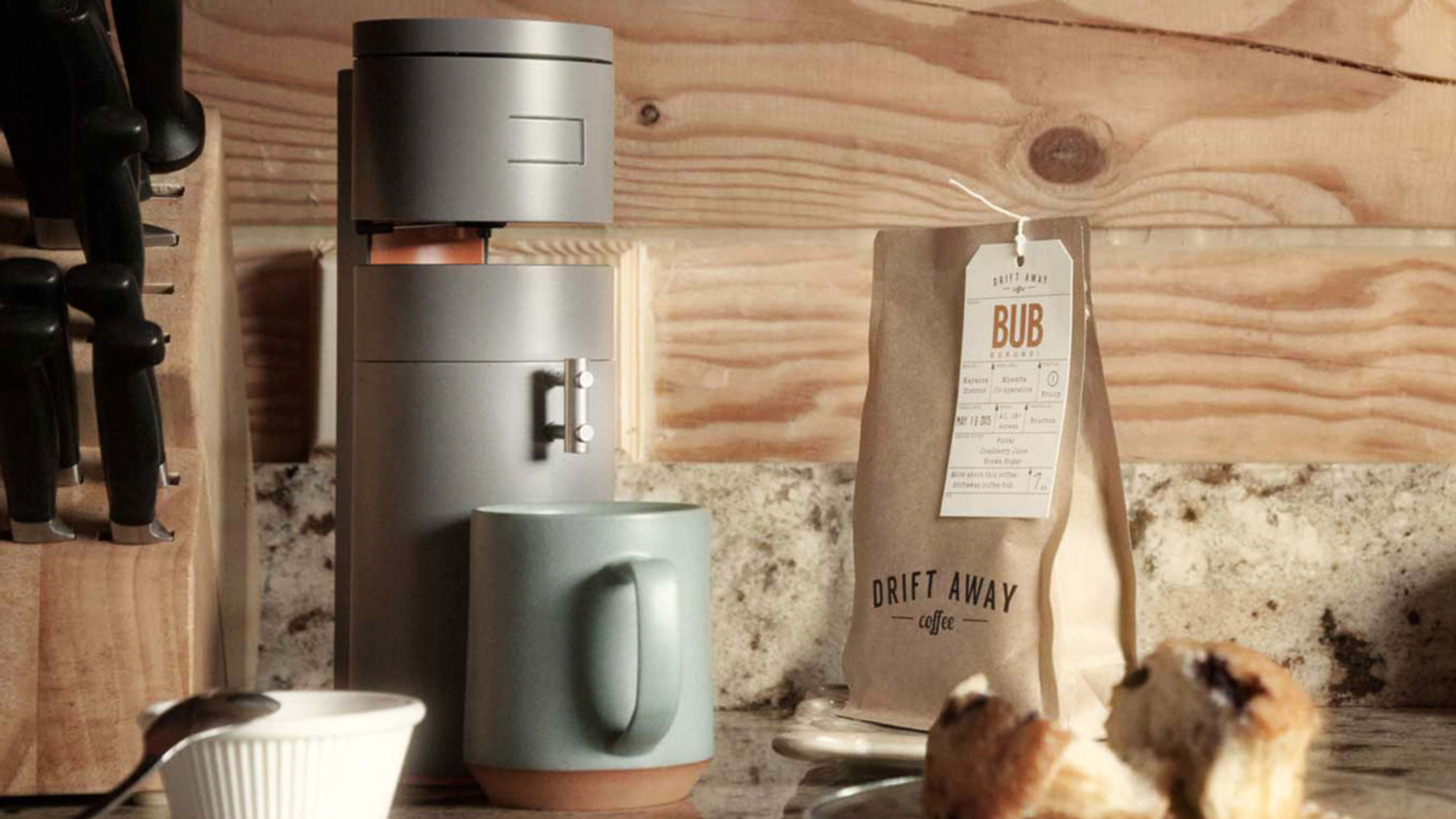Three years ago, Dustin Sell couldn’t find the connected coffee maker of his dreams, so he decided to build one.
Having acquired a taste for pour-overs at coffee shops, Sell envisioned a smart coffee machine that automated the whole process, from grinding the beans to presoaking to brewing at precise temperatures. A companion smartphone app would let users start making coffee remotely, with brewing instructions supplied by skilled roasters. After some tinkering in his spare time, Sell quit his day job as a cloud computing architect at Microsoft, and launched a funding campaign on Kickstarter.
But that project, called Bruvelo, never made it to market. Sell couldn’t reach his funding goals on two attempts, and along the way he encountered several engineering and business challenges that compromised his vision. Now, he’s uncertain whether a smart pour-over machine is even feasible.
“It’s definitely a passion industry,” Sell says. “But at the end of the day, it’s business, it’s manufacturing, and numbers, and all that.”
Sell isn’t alone in his struggles. Several other entrepreneurs have also attempted to create smart grind-and-brew coffee machines, but none have managed to ship yet. Meanwhile, some well-known companies in the coffee hardware business have experimented with the idea, and have concluded that it’s too big of an engineering challenge, with high costs that mass-market coffee consumers would never swallow. What might seem like a simple task–a superior cup of coffee at home, produced on demand–continues to vex some of the best minds in coffee.
https://www.youtube.com/watch?v=oTNemFaj6lE
All Brew, No Grind
Coffee machine maker Behmor comes halfway toward making the perfect connected product. The Behmor Connected performs the tasks expected for a good cup of pour-over: it holds water within ideal brewing temperatures of 197 degrees to 205 degrees, can presoak the grounds to release sour-tasting carbon dioxide, and uses a pulsating shower head to evenly saturate the grounds. (By comparison, a typical drip coffee maker will boil the water, forcing it through a pipe and onto the grounds in haphazard fashion.) Joe Behm, Behmor’s president and inventor, boasts of creating the only connected product that meets the Specialty Coffee Association of America’s “Golden Cup Standard” for home brewing.

Still, the Behmor Connected doesn’t perform the fundamental task of grinding the coffee beans. So while you can remotely trigger the brewing process with Behmor’s smartphone app or Amazon Alexa skill, you still have to prepare the beans ahead of time. And the more in advance you grind, the more flavor you lose.
The problem with grind-and-brew systems, Behm says, is moisture. Inevitably, steam from the brewing process winds up into the grinder chute, clogging any grounds that don’t fall into the brewing chamber. (This is a common complaint, for instance, with a non-connected grind-and-brew machine from Cuisinart.)
“They are notoriously bad, because when you do the grind-and-brew, the steam goes up that chute where the coffee feeds out, so it will get clogged up,” Behm says. “And if people don’t maintenance, and I mean maintenance it regularly, it’s a nightmare.”
This issue becomes exacerbated if users attempt to brew a second pot of coffee shortly after the first, says Kyle Anderson, the cofounder and president of grinder maker Baratza. But even if the system required a wait time between brewing, clogs may still be unavoidable.
“You go far enough up that chute, you’re going to find a little plug of coffee, and that plug of coffee will have been potentially caked together because of being exposed to steam for about four minutes during the brew cycle,” Anderson says.
The laws of physics also pose a challenge as coffee falls out of the grinder and into the brewing chamber, Behm says. Like sand in an hourglass, ground coffee will form a mound, which isn’t the ideal shape for brewing coffee. What’s normally an easy process with a Chemex or V60–just give the glass a few taps–becomes a more complex mechanical task in a machine.
“When water’s first dropped on it, unless you find a way to thump it, or level it, it’s going to cause uneven extraction,” Behm says.
Price Tags And Patents
Dustin Sell says clogging surprisingly wasn’t a major issue with his initial design for Bruvelo, but steam from the brewer did create other challenges. The steam made Bruvelo’s touch screen control panel more susceptible to damage, and would cause the circuitry for the integrated weigh scale to expand or contract, throwing off measurements when brewing several cups in a row.
To complicate matters further, Sell was approached with two patent claims during his first Kickstarter campaign. One claimant said the concept of weighing coffee on a scale before dropping it into the grinding hopper was patented, while another made a claim against Bruvelo’s back-end system for determining when to order more beans. Sell says he spent thousands of dollars to have an attorney investigate the claims, even though he doesn’t believe he infringed their patents.
When the original design fell about $15,000 short of its $150,000 fundraising goal, Sell went back to the drawing board. He removed the touch screen, and created a much simpler cylindrical design that he felt would be easier to manufacture. And instead of weighing the beans on the device, Sell designed the hopper to hold about 20 grams of coffee; Bruvelo would brew each cup with that amount in mind.
But along the way, Sell realized that manufacturing the product would be much more expensive than he originally thought. For his second campaign, he set a fundraising goal of $975,000. The project only got a little over halfway there.

“I learned a lot from it, but I had done the math,” he says. “If I took another shot on Kickstarter, let’s say I were successful, and I took it to market, I would have run out of personal funds.”
In the back of his mind, Sell wonders if the idea was even workable in the first place. He’s always wondered why major coffee maker companies haven’t tried to emulate pour-over methods themselves. Maybe the cost to produce such a sophisticated product was just too high, with too few people interested in the concept.
“In some ways, it’s a cause for concern that what you’re doing isn’t feasible from a business standpoint, because you just have this fear that they’ve done a ton of market research, and they’ve deemed it as not a profitable market,” he says.
For Baratza’s Kyle Anderson, the answer is more straightforward: He’d rather focus on making coffee grinders. Although Baratza’s grinders are widely regarded as the best, Anderson says there’s work to do on making them more reliable and foolproof for users, and that’s enough to keep him busy.
“My goal, really, is to make something that, even with the dumbest user, using the shittiest coffee, will still work,” Anderson says.

Hope Percolates
The good news for coffee snobs like me is that some companies are getting closer to a solution. Smarter, for instance, just released a second-generation version of its Smarter Coffee grind-and-brew system. The original model didn’t fare well–subpar coffee quality and tendency for clogging came up in reviews–but Smarter says it has made internal improvements and is following Specialty Coffee Association of America guidelines. (It’s unclear if the company will achieve the group’s certification, however.)
Meanwhile, another Kickstarter project called Orenda is still in development. Originally named Auroma and funded in 2015, Orenda includes a grinder, precise brew settings via a smartphone app, and brewing “recipes” from local roasters. The product was originally supposed to ship in early 2016, but like almost every crowdfunded hardware project, it’s been pushed back. Orenda recently told backers that it’s now close to shipping its first 40 units, and its website claims that pre-orders will ship in early December.
Another startup called Spinn also claims that it’s close to shipping to early pre-order customers, with the first units scheduled for early 2018. It, too, aims to work with roasters to supply fresh coffee and brewing methods to the device. But instead of a traditional pour-over method, Spinn sends coffee through a rotating drum, which uses centrifugal force to send pressurized water through the grounds. This allows Spinn to emulate various coffee styles, from a pour-over to an espresso, based on rotation speed.
“If you look at our technology, we think that we’ve made a whole new category within the coffee industry,” Spinn CEO Roderick de Rode says.
Spinn’s technology tries to sidestep a lot of the issues that have plagued other grind-and-brew systems. Instead of dropping ground coffee into the brew chamber, for instance, Spinn uses a mechanical worm wheel to push the grounds through a horizontal tube. The force of the spinning drum then creates a vacuum that minimizes how much moisture gets back into the grinder. Spinn even has a way to eject the grounds into a built-in waste container after brewing. “It’s quite a complicated process, what we’re doing,” de Rode says.
Still, de Rode won’t talk on the record about how close Spinn is to being able to ship at scale, beyond its small number of pre-orders. And to begin producing tens of thousands of units, the company needs to raise $10 million to $20 million.
Therein lies the rub: With traditional coffee makers, the best machines tend to be the ones with the fewest extraneous mechanical parts. The simpler a device is, the easier it is to manufacture, and to repair if things go wrong. This might explain why high-end coffee makers have stayed away from all-in-one machines, and it illustrates why optional subscriptions and refills are so important for Spinn. If people are willing to pay for coffee service, it could help justify the massive investment required in hardware.
“People look at Spinn as a hardware company, but we are a subscription business carried by hardware,” de Rode says. “We’re more like the dollar shave club, but the dollar coffee club.” As for Bruvelo’s Dustin Sell, he still tinkers with his prototypes on occasion. His latest idea is to build a more travel-oriented product, which would help people make pour-overs in their hotel room’s coffee mugs instead of suffering through prepackaged grounds. Although he’s still tweaking the design, he may end up going back to Kickstarter for a third attempt.
“I’ve spent a lot of time studying the costs of manufacturing, and it’s something that a lot of people overlook,” Sell says. “I just want to make sure the business side of it is solid.”
For the sake of coffee snobs everywhere, I hope it is.
Recognize your brand’s excellence by applying to this year’s Brands That Matter Awards before the early-rate deadline, May 3.
